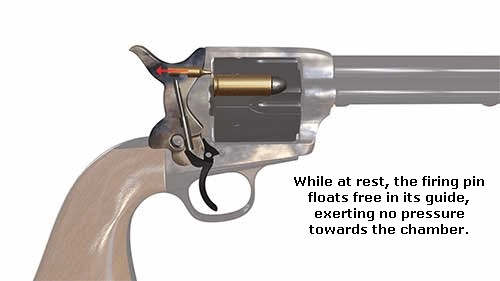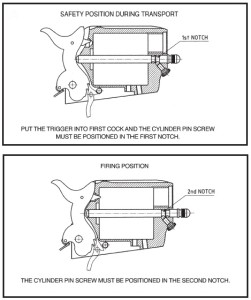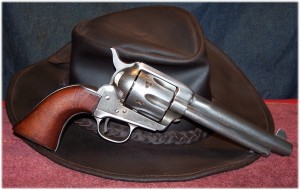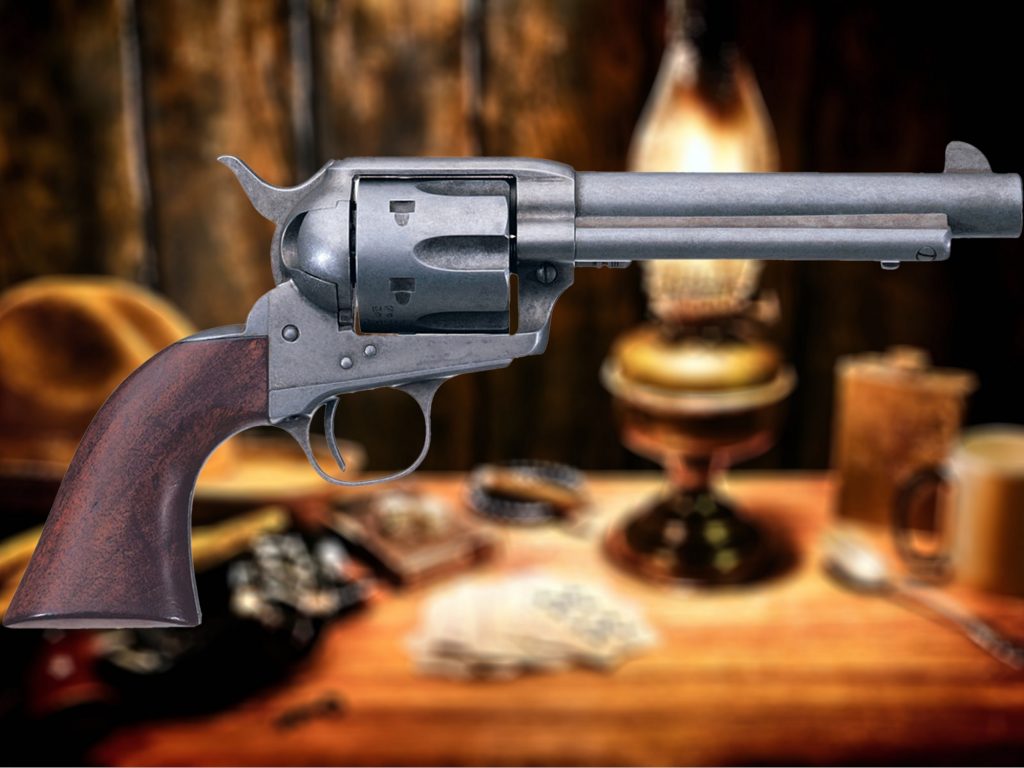
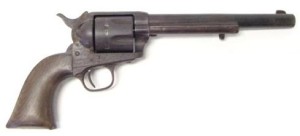 Imagine, if you will, holding in your hand an original 1st generation 1873 Colt Single Action Army revolver; the “Gun that won the West” only you don’t know that yet because it has not been termed as such. Picture if you will that you are a cowboy with $20 in your pocket (a month’s wages) and you are in need of one of the new “Peacemakers.” Chances are that you would not be looking at a perfectly polished blued gun with perfect color case-hardened steel frame, real ivory or stag-horn grips; those are rich-man’s guns. Chances are that you would be looking at an 1873 Colt that has been shot hard and put up wet. If you have ever seen the movie, “The Good, the Bad, and the Ugly” then you would be more like “Tuco” trying to make an 1873 “Peacemaker” from a plethora of parts taken from other “Peacemaker” revolvers. Ah, such is the poor man’s lot in life!
Imagine, if you will, holding in your hand an original 1st generation 1873 Colt Single Action Army revolver; the “Gun that won the West” only you don’t know that yet because it has not been termed as such. Picture if you will that you are a cowboy with $20 in your pocket (a month’s wages) and you are in need of one of the new “Peacemakers.” Chances are that you would not be looking at a perfectly polished blued gun with perfect color case-hardened steel frame, real ivory or stag-horn grips; those are rich-man’s guns. Chances are that you would be looking at an 1873 Colt that has been shot hard and put up wet. If you have ever seen the movie, “The Good, the Bad, and the Ugly” then you would be more like “Tuco” trying to make an 1873 “Peacemaker” from a plethora of parts taken from other “Peacemaker” revolvers. Ah, such is the poor man’s lot in life!
Or, perhaps an old cedar steamer trunk was found in the attic of a house that one of your ancestors lived in. As you open the steamer trunk a smaller wooden box lies in the bottom of the trunk beneath layers of old clothes from the 19th century. You open the box and there is what seems to be a bundle of oilskin rags. You cautiously peel away the layers of oilskin and you begin to see metal that has been protected by the oilskin over many years. As you pull the final layer of oilskin away, there lies an 1873 Colt Single Action Army revolver that belonged to some prior generation. The metal, no longer protected by the polished bluing that once gleamed in the sunlight, is there before you as if it’s very soul has been uncovered in the dim lighting of the attic. The wood grip; battered, worn, and shrunken with age reveals its beauty in the warm light. You slowly pull the pistol (as they were called then) from its wrapping and hold it in front of you; admiring the smooth lines as you slowly roll the pistol in your hand. Instinctively, you pull the hammer back and look down the sights as your ancestor did before you. Holding the hammer with your thumb, and with heart pumping a little faster, you pull the trigger and slowly control the hammers descent into the frame. A warm feeling is almost overwhelming as you place the pistol back into its oil-skin wrapping and place it back into the wooden box from whence it came. The thought may have come to you that you have found a national treasure and, in a sense, you are right.
Alright, enough of the romantic stuff already!
When I visited my LGS last week, there were several Uberti revolvers for sale; a stainless-steel 7-1/2” barreled Cattleman in .45 Colt, several “El Patron” revolvers (including a few competition models), an 1871 Colt Navy open-top and 1872 Colt Army open-top (both in .38 special/.357 magnum offerings. If you have been following my Uberti reproduction articles, then you would have read where I desired an 1873 Single Action Army, 7-1/2-inch barreled all-steel model that was more true to the original 1873 SAA. The “Cavalry” model was the model accepted by the U.S. Army in 1873 and I was looking for one as close to the original as possible.
I actually had the 1873 SAA, 7-1/2-inch barreled all-steel version on order, but it was lost to me when the container ship that carried mine, and many other Stoeger and Beretta firearms, sank to the bottom of the sea in a hurricane last year. Unfortunately, that particular revolver also sank from the pages of Uberti firearms as an option. I hope that Davy Jones is having fun with my revolver!
When I returned to the LGS the next week, the stainless-steel 7-1/2” barreled Cattleman in .45 Colt had been sold, but it was what took its place in the counter that caught my eye, but not at first. I have to say that the “El Patron” is a very nicely made revolver, wide and somewhat lowered hammer spur, Wolf springs throughout, and a very nice trigger. The El Patron’s shiny blued barrel and frame with a color case hardened cylinder and loading gate, coupled with some finely-checkered grips, makes the El Patron a fine pistol for competition or showing it off to friends. Competition does not interest me; whereas, owning an 1873 Colt SAA clone that does closely resemble the actual revolver does interest me; the closer the resemblance the better.
I had read about a version of the Uberti 1873 Cattleman that had a unique finish as an option, but had yet to see one in person. I asked to see the unique (I like unique and different) 1873 SAA revolver. Upon handling the piece, my mind raced back to what may have been when a poor, saddle-sore, rode hard and put up wet cowboy was looking at with $20 in his pocket and a yearning for a new revolver (new to him at least). The bluing was nearly undetectable, the grip appearing worn with age and use, but the action was superb. This piece, had it been an original 1st generation Colt SAA, would have said that someone cared about it at one time. What I was looking at was a revolver that would be considered as close to the original as any reproduction made by Uberti with many of the same features found in the original 1st generation Colt Single-Action Army revolver (with a modern twist, of course).
Let’s talk about the Uberti 1873 Cattleman II in the Old West Style configuration. I was about to put my money down on a reproduction revolver that looked as bad as that imaginary cowboy in my mind. The “Antique Patina” finish looked right at home on this “six gun.”
THE BASICS:
- Caliber: .45 Colt
- Barrel Length: 5-1/2″
- Total Length: 11.0″ (bbl 5-1/2″)
- Weight: 2.3 lbs.(bbl 5-1/2″)
- Cylinder: 6 shot, fluted
- Grip: One-piece “weathered” walnut
- Finishes: Antiqued
FIT an’ FINISH:
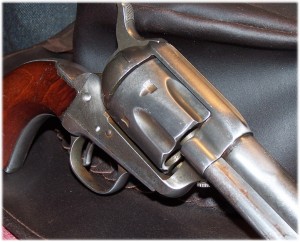 The metal-to-metal fit is superb. The ‘flash gap’ (between the cylinder and forcing cone) is less than 0.004 inches and there is absolutely no free play in the cylinder when the hammer is in the cocked position. This is one tightly-built reproduction of a not-so-tightly built original.
The metal-to-metal fit is superb. The ‘flash gap’ (between the cylinder and forcing cone) is less than 0.004 inches and there is absolutely no free play in the cylinder when the hammer is in the cocked position. This is one tightly-built reproduction of a not-so-tightly built original.
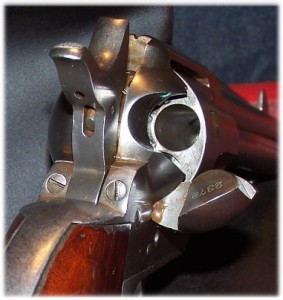 The loading gate rolls smoothly in and out of place on the frame and the hammer rolls like it was on butter. Uberti did an excellent job on this one.
The loading gate rolls smoothly in and out of place on the frame and the hammer rolls like it was on butter. Uberti did an excellent job on this one.
Uberti uses a modern process that gives a revolver a patina reminiscent of well-worn bluing and is what they call “Antique Patina.” It is apparent that this process is performed after the revolver is assembled, as remnants of bluing can be found in cracks and crevasses that would not normally be affected by holstering and normal wear. It is through a modern chemical process that provides the look. Normally, this feature is a special order because most reproduction collectors’ like polished blue finishes and I admit that I am one of those. But, the finish on the Uberti 1873 Cattleman II “Old West” is more true to form with original 1st generation Colt SAA revolvers that might be found in a merchandiser’s show case somewhere in Cattle Gap, Texas in the late 1870s.
BARREL:
The 5-1/2” barrel is cold-hammer forged affair with a 1:6 right-hand twist and incorporates the front sight, ejection rod housing, ejection rod, and ejection rod spring. The top of the barrel is roll marked, STOEGER-ACCOKEEK MD-A.UNERTI-ITALY while the left side is roll marked MODE 1873 CAL .45 COLT.
In some ways I wish that Uberti would roll mark under the barrel (as Ruger is doing these days) to keep the top of the barrel clean. At least there is no roll marked claim that the firearm is dangerous and that the user’s manual must be read before using.
SIGHTS:
The front sight is a high and thin-bladed affair with the rear sight being a notch cut in the top-strap of the receiver (the design of which was borrowed from the Remington’s New Army revolver) and which is only visible with the hammer fully cocked.
GRIP:
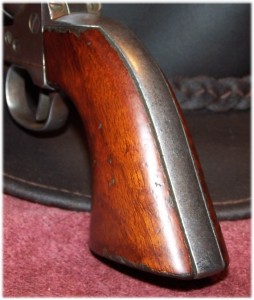 True to form, the one-piece hardwood grip emulates the grip that would be found on a well-used 1873 Colt SAA revolver. Even the slight mismatches in wood-to-steel fit are calculated to resemble the original; slightly worn and rough from use, blinding rainstorms, desert dust, and long cattle drive let alone those drunken nights at the Swinging Door Saloon. In other words, the grip is perfectly matched to the gun. I expected to see a couple of notches on the grip, but the grip on this revolver has never been in a gun fighter’s hand.
True to form, the one-piece hardwood grip emulates the grip that would be found on a well-used 1873 Colt SAA revolver. Even the slight mismatches in wood-to-steel fit are calculated to resemble the original; slightly worn and rough from use, blinding rainstorms, desert dust, and long cattle drive let alone those drunken nights at the Swinging Door Saloon. In other words, the grip is perfectly matched to the gun. I expected to see a couple of notches on the grip, but the grip on this revolver has never been in a gun fighter’s hand.
The grip is actually dark brown and what appears to be walnut. This is in contrast to the somewhat reddish color of most of the grips from Uberti. The grips emulate years of being gripped and handled in the worthy hands of a ‘Shootist’ of the Old West.
 The grip length is perfect for my hand when I obtain the high grip position, which to me is with the cocked hammer just resting against the fleshy part between the thumb and trigger finger part of my hand. This is the best spot to manage the recoil and muzzle flip. After firing, the thumb catches the hammer groove and cocks the hammer as the barrel is forced downward. This grip also get the bore axis of the barrel almost inline with the hand and arm when shooting from the ‘duelist’ position.
The grip length is perfect for my hand when I obtain the high grip position, which to me is with the cocked hammer just resting against the fleshy part between the thumb and trigger finger part of my hand. This is the best spot to manage the recoil and muzzle flip. After firing, the thumb catches the hammer groove and cocks the hammer as the barrel is forced downward. This grip also get the bore axis of the barrel almost inline with the hand and arm when shooting from the ‘duelist’ position.
If I get a low grip on the gun, my little finger hangs off of the grip, but it can be useful there as well to help mitigate muzzle rise.
ACTION:
While the Uberti 1873 Cattleman II in the Old West Style does not have Wolf springs like the “El Patron” model, the action is superb. Like the original. There are four clicks to be heard; “C-O-L-T” and are as distinctive as the name itself.
Trigger pull weight is right at 4-pounds of pull with no take-up, a very crisp and definitive break, and absolutely no over-travel. I wish that I had some 1911 pistols with a trigger this good.
The hammer is thin and high with a nice valley in which to catch the crook of the thumb when the hammer is being cocked. To assist the thumb in cocking the hammer is a finely serrated hammer spur.
True to the original Colt SAA, the hammer must be at half-cock to load/unload the cylinder via the loading/unloading gate. True to fashion, these revolvers dictate a load one-skip one-load four loading to prevent the firing pin from contacting a live cartridge. However, Uberti has built in a few safeties that help to mitigate NDs (see, SAFETIES). The hammer is then pulled to the full-cock position and either lowered to the “rest” position with the thumb or lowered quickly by pulling the trigger to fire the gun.
FRAME:
The frame is of cold hard-forged steel and has, of course, the ‘Old West” treatment to give the ‘Old West’ look.
The patent information, (PAT SEPT. 12 1871 and PAT JULY 2 1872) is stamped into the left side of the frame. Just forward of the trigger guard is the unit’s serial number.
The frame features a button-style ejection rod that assists the shooter in ridding the revolver of fired casings, and it does so quite well. With some of the shorter-barreled revolvers, the ejector rod is not long enough to completely clear the fired cases from the revolver and the fired cases would have to be plucked from the chamber with a fingernail.
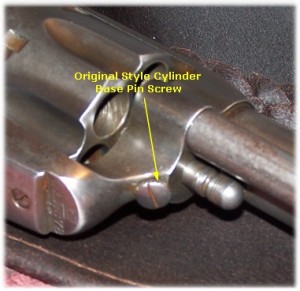 The frame also houses the cylinder base pin, which on the ‘Old West” model is removed and installed by loosening a base pin screw that is on the front of the receiver and below the cylinder base pin. (Note that the use of the base pin screw is more true to the original Colt SAA revolver and in 1896, at serial number 164,100, a spring-loaded base pin latch replaced the cylinder pin retaining screw. A spring-loaded base pin latch is commonly found on Uberti’s New Model series of revolvers.) Apparently, Uberti is aware of the fact that one could lose the base pin screw and provided a second one. A dab of blue or purple thread locker should be enough to keep it in place, but it still needs to be checked periodically when firing the revolver, and I am sure that some of those who carried the original 1873 Colt Single Action Army lost a few in their time.
The frame also houses the cylinder base pin, which on the ‘Old West” model is removed and installed by loosening a base pin screw that is on the front of the receiver and below the cylinder base pin. (Note that the use of the base pin screw is more true to the original Colt SAA revolver and in 1896, at serial number 164,100, a spring-loaded base pin latch replaced the cylinder pin retaining screw. A spring-loaded base pin latch is commonly found on Uberti’s New Model series of revolvers.) Apparently, Uberti is aware of the fact that one could lose the base pin screw and provided a second one. A dab of blue or purple thread locker should be enough to keep it in place, but it still needs to be checked periodically when firing the revolver, and I am sure that some of those who carried the original 1873 Colt Single Action Army lost a few in their time.
The cylinder base pin also serves as a safety (see SAFETIES).
CYLINDER: The cylinder on this particular model holds six .45 caliber Long Colt cartridges. It is fluted, as was the original. While the cylinder is made of modern materials, it is recommended that “cowboy” loads be fired to increase longevity and also safety.
The cylinder on this particular model holds six .45 caliber Long Colt cartridges. It is fluted, as was the original. While the cylinder is made of modern materials, it is recommended that “cowboy” loads be fired to increase longevity and also safety.
A cylinder base pin secures the cylinder to the frame and allows it to turn free when the hammer is at the half-cock position. Each chamber of the cylinder loads and unloads through the loading gate. Although Uberti has incorporated a new safety in the Cattleman II series of revolver, it is still advised to load only five in the chambers of the cylinder while resting the hammer on an empty chamber.
SAFETIES:
My hat is off to Uberti for incorporating safeties that are not visible and would otherwise detract from the gun’s appearance.
Although Uberti has incorporated a new safety in the Cattleman II series of revolver, it is still advised to load only five in the chambers of the cylinder while resting the hammer on an empty chamber. (I understand that Uberti also has a line of revolvers that incorporate a hammer block safety for those who don;t mind such a thing.)
Firing Pin Safety:
The Uberti Cattleman II with retractable firing pin is a breakthrough for those seeking enhanced safety with regard to original Old West revolvers without sacrificing the visual authenticity of a 1st-generation Colt.
As any cowboy knows, the safest way to carry a single-action is with the hammer resting on an unloaded chamber. This is true even for the Uberti retractable firing pin design. But in the case of the Uberti design, the risk of accidental discharge is reduced: the firing pin is not locked into the firing position unless the trigger is pulled.
This enhanced safety feature is available without a visible transfer bar safety, which those who insist on visual authenticity might not want. In other words, from the outside this revolver’s looks and operation are identical to those of an original.
See the animation below for a full explanation.
To ‘safe” the revolver:
- First, loosen the cylinder base pin screw in the frame.
- Place the hammer in the safety notch position by moving the hammer rearward until you hear the first click. When in the proper position, the hammer will rest ¼-inch from the frame.
- Push the cylinder base pin into the frame as far as it will go. The stop ring on the cylinder base pin will be against the front of the frame. The other end of the cylinder base pin will rest against the front of the hammer.
- Tighten the cylinder base pin screw.
Note: Do not rely solely on this safety; this is a voluntary safety and not an automatic safety.
To ‘fire’ the revolver:
- First, loosen the cylinder base pin screw in the frame.
- Place the hammer in the safety notch position by moving the hammer rearward until you hear the first click. When in the proper position, the hammer will rest ¼-inch from the frame.
- Pull the cylinder base pin from the frame until both detents in the cylinder base pin are visible.
- Insert the base pin to the first detent.
- Tighten the cylinder base pin screw. The revolver is now ready for normal operation.
In addition, there is also a “rest” position for the hammer. The “rest” position is one click rearward on the hammer. This position is used to insert the cylinder base pin to its safe position; the two work in tandem so to speak. The “rest” hammer position should only be used in conjunction with the cylinder base pin and not relied upon as a safety under its own merits.
THE WEIGHT OF IT ALL:
The Uberti 1873 Cattleman II “Old West” weighs in at 36.8 ounces (2.3 pounds) unloaded. By comparison, the Ruger Vaquero (blued) weighs in at 40 ounces (2.5 pounds) unloaded. Also by comparison, the original 1873 Colt Single-Action Army weighed 36.97 ounces (2.31 pounds) unloaded. The Uberti 1873 Cattleman II “Old West” is slightly lighter than the original 1873 Colt SAA but not so much to be noticeable.
RANGE TIME:
 Although the Uberti reproductions are tested at 3 times the gun’s operating pressure, I see no need to test that limit and confine my shooting to “cowboy” loads. This session’s loading was 250-grain RNFP running at about 725fps and was purchased through Georgia Arms.
Although the Uberti reproductions are tested at 3 times the gun’s operating pressure, I see no need to test that limit and confine my shooting to “cowboy” loads. This session’s loading was 250-grain RNFP running at about 725fps and was purchased through Georgia Arms.
A simple silhouette target was run 10 yards downrange and I loaded up the first five rounds like a good cowboy should; load one, skip one, load four. Single-action revolvers were meant to fire one-handed and that was my intent as I took up a “Duelist” stance. That thin front sight seemed even thinner as I tried to put it in the rear notch, but nonetheless the first shot went downrange on the target. I expected a little high and left and I wasn’t disappointed. I adjusted the trigger finger slightly and commenced to place the remaining four shots the best that I could.
Fast forwarding to fifty rounds later, I was able to take out the center of the target and place the majority of my shots in the 9-ring. I was quite satisfied with the Uberti 1873 Cattleman II “Old West” model revolver and, as usual, I find these Uberti reproductions far more accurate than I am with my hand getting shakier and my eyes getting older. While I did try the two-hand, off-hand hammer cock I found that I was more comfortable firing this gun off-hand and one-handed; it just seemed to be the right thing to do.
FINAL THOUGHTS:
 Collecting and shooting replicas of single-action revolvers used in that period of American history when the land was being settled and tamed, and even during some unsettling times, is both rewarding and relaxing.
Collecting and shooting replicas of single-action revolvers used in that period of American history when the land was being settled and tamed, and even during some unsettling times, is both rewarding and relaxing.
While I appreciate Sturm Ruger, Ruger and Company’s attempt at keeping the single-action revolver alive, as well as Colt continuing production of the SAA revolver, I appreciate Uberti’s value and also commitment in keeping the Old West alive through its reproduction efforts. The feel of a Ruger Blackhawk or Vaquero is just not the same as with Uberti reproductions and while I understand that the Ruger SA revolvers can handle some pretty hot loads, there is absolutely nothing wrong with putting some ‘Sunday’ loads down range in a relaxing manner.
While I plan to add a couple more Uberti single-action revolvers to the collection (Colt Bisley – introduced in 1894, Smith & Wesson New Model 3 – 1877 (although they were made from 1870 – 1915), the Remington 1890 New Army – the last Remington revolver made and sold until 1896, and the 1873 Cattleman II in the original 7.5″ barrel length), having what I now have in the collection gives me the satisfaction of being able to shoot reproductions of these firearms and is alright by me and my pocketbook, as an original would be well beyond my means (All original, good condition, U.S. Cavalry and Artillery Single Action Armies (those produced between 1873 and 1891) are among the most valuable to collectors and can bring upwards of $10,000)
The Uberti 1873 Cattleman II “Old West” model revolver is as true to the original 1st generation Colt SAA “Artillery” model as I believe that I can get. The finish of the Uberti 1873 Cattleman II “Old West”, while not exact to the true finish of an actual firearm, which takes years to take on the patina and richness of bluing worn through many hands and holsters, is close enough for me. The Uberti 1873 Cattleman II “Old West” is a fine piece of ‘Old West” representation with improved durability and reliability over the original 1873 Colt Single Action Army.
The overall feel of the Uberti 1873 Cattleman II “Old West” is very balanced. Although I like the 7.5-inch “Cavalry” model, the 5.5-inch barrel (which would be considered the “Artillery-length” model) feels as good in my hand as does the 1911-based pistol that I carry every day. Both, it seems, are .45 calibers – will you fancy that!
RESOURCES:
1873 Cattleman II Revolvers: http://www.uberti.com/1873-cattleman-ii-revolver
OTHER UBERTI REVIEWS:
Be sure to check out my other reviews of Uberti products…
- Uberti 1872 Army Open-Top Revolver (New Model 341350) – Review: https://guntoters.com/blog/2015/12/10/uberti-1872-army-open-top-revolver-new-model-341350-review/
- 1875 Remington ‘Outlaw’ by A. Uberti: https://guntoters.com/blog/2015/09/21/1875-remington-outlaw-by-a-uberti/
- 1858 Remington New Army Conversion by A. Uberti: https://guntoters.com/blog/2015/08/29/1858-remington-new-army-conversion-by-a-uberti/
- 1871 Navy Colt Conversion (Early Version) by A. Uberti: https://guntoters.com/blog/2015/09/01/1871-navy-colt-conversion-early-version-by-a-uberti/
![]()


